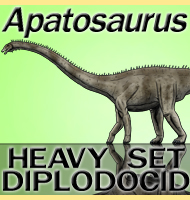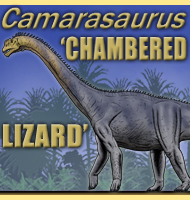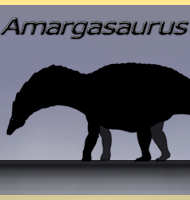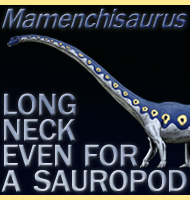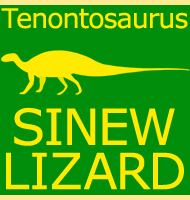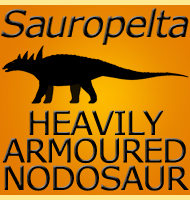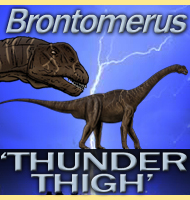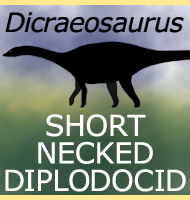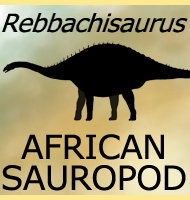


Sauroposeidon
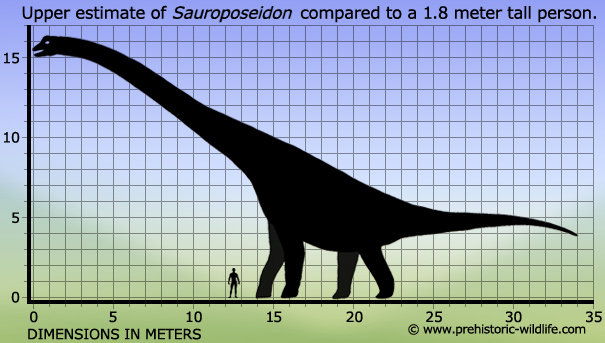
Name:
Sauroposeidon
(Poseidon lizard).
Phonetic: Sore-o-ps-sy-don.
Named By: Wedel, Cifelli & Sanders -
2000.
Synonyms: Paluxysaurus.
Classification: Chordata, Reptilia, Dinosauria,
Saurischia, Sauropodomorpha, Sauropoda, Macronaria,
Brachiosauridae.
Species: S. proteles (type).
Diet: Herbivore.
Size: Uncertain due to incomplete remains but
comparison to similar dinosaurs has yielded estimates of between 28
and 34 meters long, with a the head capable of being raised up
to 17 meters off the ground.
Known locations: USA, Oklahoma - Antlers
Formation.
Time period: Aptian to Albian of the Cretaceous.
Fossil representation: 4 mid cervical (neck)
vertebrae and cervical ribs.
When
looking up what is the biggest dinosaur, people usually get presented
with the image of a sauropod,
but the exact owner of this title
depends upon a number of factors, particularly the definition of
largest be it by length, height or weight. Although incomplete,
Sauroposeidon is thought to be one of the largest
dinosaurs but not
necessarily ‘the’ largest. It does however appear to have been
one of the last of the giant sauropods alive in North America since
remains are dated to the Aptian to Albian stages of the early
Cretaceous. Even by this time the sauropods were rare when compared
to their numbers in the late Jurassic and eventually they seem to have
been replaced by ceratopsian
dinosaurs and hadrosaurs
as the dominant
herbivores.
The
first remains of Sauroposeidon were discovered in
1994 by a team
led by Dr. Richard Cifelli, however at the time they were
misidentified as petrified tree trunks. It was not until 1999
when Cifelli removed them from storage and passed them onto Matt Wedel
for study that their real identity of being sauropod vertebrae was
discovered. What really made the discovery exciting was the sheer
size of the vertebrae that were some of the largest ever seen. The
remains were officially named Sauroposeidon in
2000, but
Sauroposeidon still made headlines towards the end
on 1999 when the
discovery was announced in a press release.
This
sparked a short lived media sensation about the discovery of the
biggest dinosaur, but as is often the case concerning stories about
palaeontology, the headline got in the way of the facts. The
vertebrae came from a very big dinosaur but the only clue we have to
the size of Sauroposeidon is comparison to related
dinosaurs with a
similar body form. For this purpose palaeontologists used
Giraffatitan
due to it having some of the most complete remains,
although a complete skeleton from a single individual is still
unknown. Comparison to Giraffatitan has allowed
for reconstructions
of Sauroposeidon where it was capable of lifting
its head to around
seventeen meters off the ground, something which if accurate would
place Sauroposeidon as the tallest dinosaur.
However
the comparison to Giraffatitan may not be perfect
because while
Sauroposeidon has longer vertebrae, the overall
construction suggests
that Sauroposeidon was more gracile, which
basically means more
lightly built. This has led to speculation that Sauroposeidon
may
have had a neck that when compared to the size of the body, was
proportionately longer than that of Giraffatitan.
The cervical ribs
that supported the girth of the neck also suggest that the neck was
lightly built despite its large size. As such it seems that like with
other sauropods, as Sauroposeidon got larger the
body changed to be
not as heavily built as its smaller relatives. This is a clever
progression as it means the body would not require a directly
proportional increase in calories to fuel a more massive body,
however it also means that Sauroposeidon is
unlikely to claim the
title of largest dinosaur in terms of weight. At the time of writing
the best contenders for biggest dinosaur are Argentinosaurus
from
South America, or possibly even Amphicoelias.
When
fully grown Sauroposeidon was virtually ‘attack
proof’ since even
the largest predator known to be active in North America at the time,
Acrocanthosaurus,
would have probably been less than half the length
and many times lighter than Sauroposeidon.
However before an
individual attained this size it would need to spend many years as a
much smaller juvenile and here is where the danger of predators like
Acrocanthosaurus would have been at its greatest.
Additionally the
large dromaeosaur
Utahraptor
was also active in North America at
roughly this time and with its size advantage over other related but
generally smaller dinosaurs, it could have easily killed a very young
Sauroposeidon.
The
name Sauroposeidon is a reference to the Greek god
Poseidon, who
while usually depicted as a deity of the sea, also held domain over
earthquakes. With Sauroposeidon being such a
large and heavy dinosaur
weighing many tons, it was thought to shake the ground like there was
an earthquake when it walked, hence the connection.
Further reading
- Sauroposeidon proteles, a new sauropod from the
Early Cretaceous of
Oklahoma. Journal of Vertebrate Paleontology 20 (1): 109–114 - M. J.
Wedel, R. L. Cifelli & R. K. Sanders - 2000.
- Osteology, paleobiology, and relationships of the sauropod dinosaur
Sauroposeidon. - Acta Palaeontologica Polonica 45:
343–3888. - M. J.
Wedel, R. L. Cifelli & R. K. Sanders - 2000.
- Sauroposeidon: Oklahoma's Native Giant. -
Oklahoma Geology Notes 65
(2): 40–57. - Mathew J. Wedel & Richard L. Cifelli - 2005.
- A new titanosauriform sauropod (Dinosauria: Saurischia) from the
Early Cretaceous of central Texas and its phylogenetic relationships. -
Palaeontologia Electronica 10 (2). - Peter J. Rose - 2007.
----------------------------------------------------------------------------
Random favourites
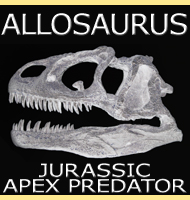 |
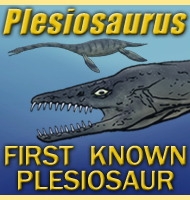 |
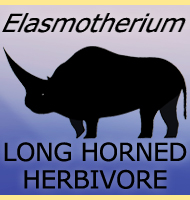 |
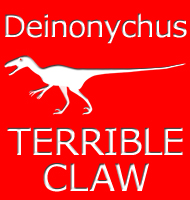 |
